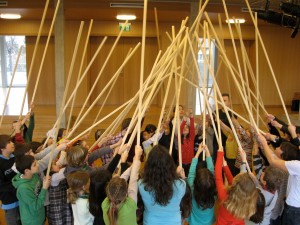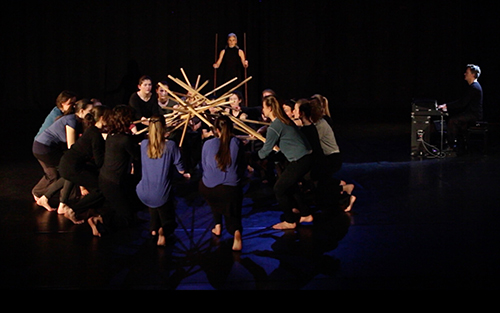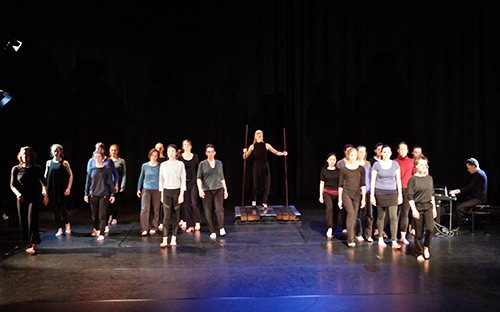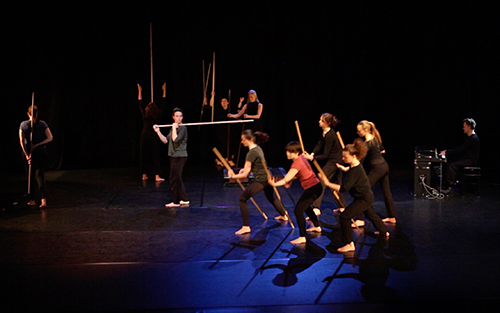Workshops
Ania Losinger offers workshops for adults and children to schools, conservatories and for teacher trainings and conferences. The workshops are flexible and can be tailored to be a few hours long or to encompass a week’s project. They can also be booked as a complement to a live-performance with Xala.
The counterpart to the workshops abroad is called RUMI INSIGHTS. With RUMI INSIGHTS, Ania Losinger and Mats Eser invite you to the atelierhouse in Rumisberg, where they live and work, and open up the space for interested parties to gain an insight into their work in small groups. In addition to trying out Xalas and other exclusive percussion instruments, this also includes (re)discovering their own rhythmic structures in terms of sound or dance, developing ideas for live performances together – and much more…
FOOT – HAND – STAVE
The centerpiece of this workshop is an object that has been reduced to the basics, a six foot high spruce stave. The freedom which is achieved by this reduction permits the creation of dynamic patterns of movement, play and rhythm based on simple structures. The stave becomes a chiming bar and in combination with stamping and voice, a creative element within movement and space, a trigger for scenic images and mental associations. By itself or used within a group choreography, it playfully translates the body into vibration and awakens the senses to an impartial experience of music and movement.
The artistic possibilities inherent in “Foot, Hand and Stave” are evident in the internationally reknowned concert performances and music theater productions by Ania Losinger.
MUSIC & MOVEMENT (Workshop & Performance)
Each movement can be understood as sound in space. When a second movement follows a time based structure is formed: rhythm. A series of movements becomes a rhythmic and dynamic tapestry of sound and is ruled by clear musical laws. These three rules also apply in the when movement and sound are reversed and formed the basis, along with the concept of creating music by using ones entire body, of the invention of the Xala. The Rhythmics expert Ania Losinger plays her instrument with flamenco shoes and two six-foot high staves . Together with multi-instrumentalist and composer, Mats Eser, she develops concert performances and music-theater pieces that have been performed worldwide.
Students in the Music & Movement Workshops learn how to create rhythmic structures and to weave them together into complex patterns using Xala staves, the resonance of the floor and the movement of their entire body. They experience the creation of a multilayered choreographic composition which takes into consideration both sound and space. At the end of the workshop, participants will exhibit their newly gained insights by performing in a music and dance performance and their newly created materials will become part of the synergy between the electro-acoustic Xala III and the Fender Rhodes or Drums/Perussion.
About my Workshops: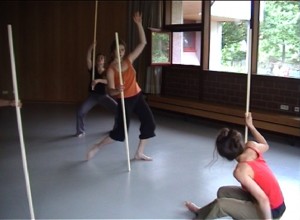
In order to explain my pedagogy I would like to briefly mention my current artistic work.
In 1998/99 together with instrument builder and inventor, Hamper von Niederhäusern, I developed the first floor xylophone in the world, the Xala. It was born of my longtime desire to create music by dancing. With flamenco shoes and six foot high staves, I transform the movement of the body into rhythmic and melodic sound sculptures. Through this process a synthesis of music and movement is achieved which I bring to life on the stage in a series of solo concert performances and working together with diverse ensembles.
The first requests for workshops for children and young adults I received encouraged me to investigate not only the artistic but also the curative pedagogic potential of the Xala.
Making music with ones feet also means to make music with ones entire body: Playing with shifting ones weight, balance or upright tension, the unmistakable effect the application of body weight and strength has on the dynamics of audible sounds and feeling the way notes vibrate within the body. The list goes on.
This work with Xala increases body consciousness and the inner and superior cognitive ability, it has a centering effect and promotes concentration, coordination and independence.
Music conservatories are showing renewed interest in my pedagogic work. Their focus is not primarily on learning to play the Xala, but rather on the themes that are touched on while doing so. this is also possible on an ordinary wooden floor and without using special shoes. I work primarily with rhythmic movements, clapping, stamping, breath, voice, Xala Staves and “grounding notes” that I have developed myself.
This full-body musical experience can be made while improvising freely, yet the rhythmic and metric work interests me most on a personal level. I would like to make it possible to experience how a specific vibration which carries and relaxes the body is transferred to it through the repetition of rhythmic sequences.
The musical themes that are developed are first and foremost, pulse, polymetric, rythmic interdigitation and Ostinato used as an autonomous artistic means of expression. The repetition of visible, audible and tactile vibrations awakens us to the slightest changes (phrasing) in sound and movement and makes a deeper experience of freedom within structure possible.
The Xala Staves that have become more and more the central focus of the Workshops, also are conducive to enjoyable danced sequences of motion, group choreographies, exercises in pantomime and theatrical moments.
I thank the dance pedagogues, Katja Wyder and Hedda-Maria Hofmann (Doron-Tanz) for their inspiration, the encouragement and the support that they continue to give to me and to my work.
“With the idea of standing on an acoustic sounding board I was able to fulfill my dream of uniting music and dance in equal measure within a single person. I move upon a sounding floor, the Xala, whose structure is like a vast landscape. I constantly find new ways in which to blend characteristic tonalities and to give them shape. As they bear me, they answer me with the corresponding energy which I set free as I dance and thus inspire the repetition of movement. In this rhythmic dialogue a sounding space is created which has many vibrational layers. There are no limits to the images one can come up with and a deeper perception becomes possible.
It is important to me that all people who wish to make a sensual journey to the land of hearing eyes and seeing ears, be able to participate in this space.














